How to Block Youtube Ads on Safari
Key points:.
- YouTube ads can be annoying and intrusive, and some users may want to block them on Safari.
- There are different methods to block YouTube ads on Safari, such as subscribing to YouTube Premium, ad blocker extensions, and browsers with ad block.
- Ghostery is a YouTube ad blocker extension for Safari that’s free and powerful, and lets you block ads and trackers on YouTube and other websites.


Block Youtube Ads on Safari
YouTube is one of the most popular video-sharing platforms in the world.
By June 2022, more than 500 hours of video were uploaded to YouTube every minute, which is about 30,000 hours of uploaded content per hour .
However, videos are interrupted often by ads, and they’re often irrelevant to your interests.
And while Safari comes with some built-in tracking protection , it does not block ads without using a browser extension.
We’ll explain different ways to block YouTube ads, including subscribing to YouTube Premium, using an ad blocker, or downloading a browser with ad blocking built-in.
Why Block YouTube Ads
YouTube ads are a way for the platform to generate revenue and support its creators, but some ads are more intrusive than others.
The main form of YouTube ads are:
- Pre-roll ads: Play before the video starts. They can be skippable or non-skippable, and they can last from 5 seconds to 20 seconds or more.
- Mid-roll ads: Play during the video, usually at a predetermined time. They can also be skippable or non-skippable, and they can interrupt the flow of the video.
- Post-roll ads: Play after the video ends. They are usually skippable, but they can still be annoying if you want to watch another video right away.
These types of ads can negatively affect your YouTube experience in several ways.
For example, YouTube ads:
- Waste your time and bandwidth by forcing you to watch something you are not interested in.
- Interrupt your concentration and enjoyment by breaking the continuity of the video.
- Expose you to unwanted or inappropriate content that may not match your preferences or values.
- Track your online activity and collect your personal data for advertising purposes.
So you may wonder, “Can you block ads on YouTube?”
Here’s how to automatically skip ads on YouTube.
Methods to block YouTube ads on Safari
There are different ways to block YouTube ads for Safari.
YouTube Premium
YouTube Premium is a subscription service that offers several benefits for YouTube users. You can:
- Videos without ads: Watch any video on YouTube ad free.
- Offline videos: Download videos to watch them later without an internet connection.
- Background play: Play videos in the background while using other apps or when your screen is off.
- YouTube Music: Access a music streaming service with millions of songs and playlists.
- YouTube Originals: Watch exclusive shows produced by YouTube.
YouTube Premium includes a one-month free trial for new users.
Ad blocker Extensions for Safari
Another way to block YouTube ads on Safari is to use an ad blocker extension for Mac , iPhone , and iPad . An ad blocker extension is a software that blocks or filters out unwanted ads from websites.
There are many ad blocker extensions available for Safari, and one of the best ones is Ghostery Ad Blocker . Ghostery’s Safari YouTube ad blocker is a powerful tool that blocks ads on YouTube and other websites.
With Ghostery’s ad blocker extension, you can:
- Block ads on YouTube, including pre-roll, mid-roll, post-roll ads.
- Stop trackers that may slow down your browser or compromise your privacy.
- Whitelist specific websites that you want to support or see ads from.
Ghostery’s ad blocker extension is free and easy to install.
How to Install Ghostery's Ad Blocker Extension on Safari
To install Ghostery’s Safari ad block extension:
- Go to our website and click on Get Ghostery .
- Follow the on-screen instructions to add the extension to your browser.
- Enjoy an ad-free browsing experience with Ghostery!
Never installed a browser extension on Safari? Check out our instructions on how to get started or watch our YouTube video guide .
Once you’re finished, you can block YouTube ads on Safari on almost any website you visit.
Browsers with Ad Block
If you do not want to add an extension to Safari, then another option to block YouTube ads is to use a browser with ad block. An ad-blocking browser is a web browser that has a built-in ad blocker that automatically blocks ads from websites.
One of the best ad-blocking browsers is the Ghostery Private Browser .
Ghostery Private Browser is a fast, private browser that offers a smooth and ad-free browsing experience. With it, you can:
- Block ads on YouTube and other websites without installing any extensions or making further configurations.
- Protect your privacy and security with features such as private browsing windows and anti-phishing protection .
- Browse faster and save data by reducing page loading time and bandwidth consumption.
Ghostery’s Private Browser is free and easy to use. You can download it here .
TIP: Click here for ways to protect your privacy on Safari.
Final Thoughts
YouTube ads can be a nuisance for many users who want to enjoy their favorite videos without interruptions or distractions. Fortunately, you can block ads on YouTube using Safari by:
- Signing up for YouTube Premium and getting ad-free videos and other benefits.
- Installing Ghostery’s ad blocker extension to stop ads and trackers on YouTube and other websites.
- Downloading Ghostery Private Browser with a built-in ad blocker feature.
Whichever way you choose, you can start blocking ads on most websites.
Get in touch if you have any questions. We’re always happy to help.
Related articles

Unveiling the Reality: Why You Don't Need a VPN on Your iPhone

Top YouTube Alternatives
The Ultimate Anti-Tracking Guide for 2024
YouTube’s New Anti-AdBlock Walls
You may have noticed that YouTube now shows anti-ad block walls to users. While our teams are working hard to figure out what we can do to continue offering a superior user experience, AdBlock continues to block pop-ups and other annoying ads for you across the web.
Block YouTube Ads with AdBlock
YouTube is one of the most popular destinations on the Internet. But unskippable ads that run before, during, and after videos can make YouTube unbearable. With AdBlock, you can block YouTube ads and take control over your YouTube experience .
YouTube Ad Blocking Options
AdBlock blocks YouTube ads by default, and we provide powerful tools to customize how you block ads on YouTube.
YouTube Channel Allowlisting AdBlock is the only YouTube ad blocker with an easy-to-use option for allowing ads on your favorite channels, making it simple to support content creators.
Pause/Unpause Use AdBlock's Pause feature to turn AdBlock off temporarily. Please note: you will see ads when AdBlock is paused.
Prefer YouTube in dark mode? Prefer YouTube in dark mode? AdBlock includes an optional dark mode theme for the AdBlock menu and Options pages.
Blocking Ads on YouTube
We block billions of YouTube ads per month, which is why we are one of the best ad blockers for YouTube . Install AdBlock today and say goodbye to:
- Unskippable video ads
- Sidebar ads
Block YouTube Ads Wherever You Go
Take control of your YouTube experience no matter how you choose to browse. Block YouTube ads in Chrome, Firefox, Edge, Safari, Android or iPhone .
More Than a YouTube Ad Blocker
AdBlock does more than block YouTube ads, it actually makes YouTube better! Use AdBlock to decrease page load times, protect yourself from malware and adware , and more.
Install AdBlock and experience:
- Faster video loading
- Malware protection
- Uninterrupted playlists
In order to provide you with the best experience, we use some cookies on our website. Using our site means you are aware that we are using cookies and grant us permission to do so. You may change these permissions any time. Learn more.
Used to remember your privacy preferences. They cannot be switched off.
We use these to analyze website traffic.
How to Use a YouTube Ad Blocker on iPhone
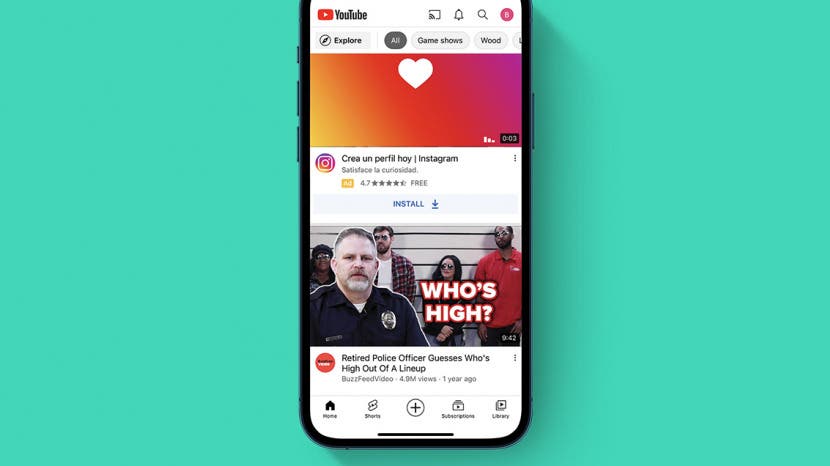
YouTube is the most widely-used platform for sharing and watching videos, but no one enjoys its ads, which are annoying, intrusive, and often unskippable. There are two main options for viewing YouTube without ads, and they each have have their pros and cons. In this guide, we'll help you pick one and show you how to set them up.
Choosing a Method
Creating a google account, signing up for youtube premium, using an ad blocker for youtube.
Before proceeding, you should decide whether you want to remove ads by subscribing to YouTube Premium or by using an ad blocker.
YouTube Premium
- Pros: Ad-free video watching, play videos in the background, download videos, YouTube Music Premium access, monetized YouTubers you watch still receive compensation.
- Cons: Monthly cost ($15.99/month for an individual membership, or $22.99/month for a family plan), must sign up for a Google account.
Ad blockers
- Pros: Available for free, ad blocking tools can help you on other sites in addition to YouTube, no need to sign up for a Google account.
- Cons: May not always work, requires additional setup, requires downloading additional apps.
How to Remove Ads with YouTube Premium
If money isn't a concern, the simplest solution is to subscribe to YouTube Premium. The downside of this solution is obvious: the cost ($15.99/month for an individual membership, or $22.99/month for a family plan). The upsides are varied: ad-free video watching, videos continue to play even while the app is in the background, the ability to download videos to watch later, and access to YouTube Music Premium.

Before you can sign up for YouTube Premium, you must have a Google account. If you already have one, you can skip to the next section .
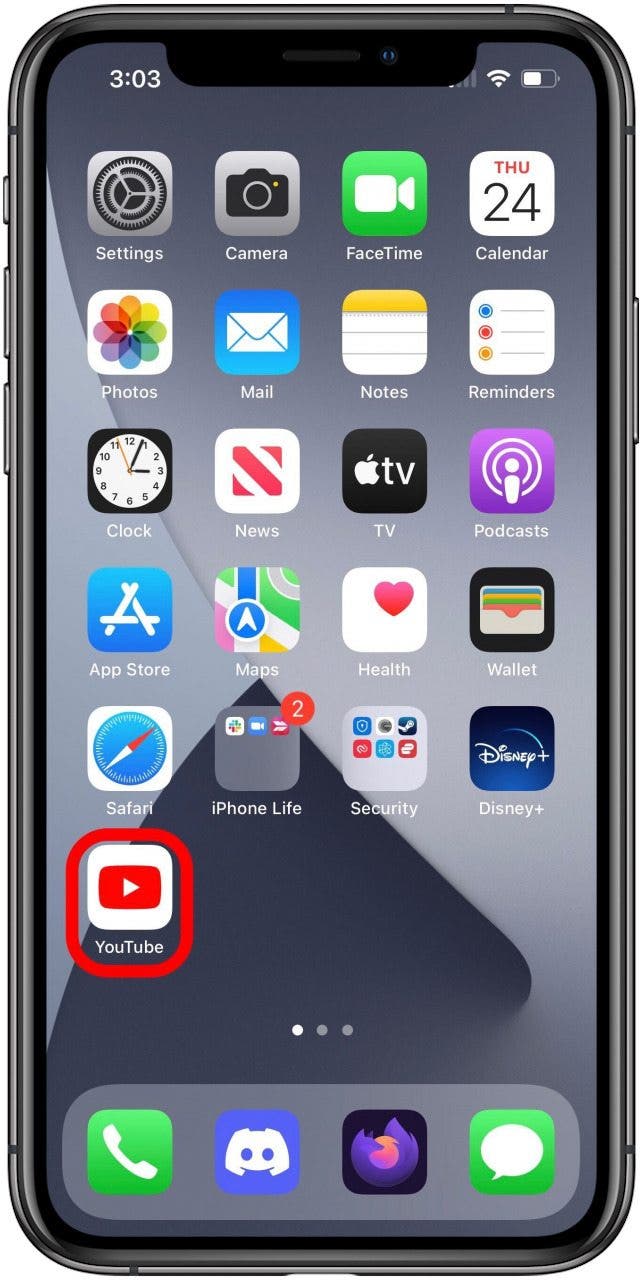
At this point you will be redirected to your browser and the Google site to sign in to your account. Follow the on screen directions to create a new account. After this, you should automatically be sent back to YouTube, now logged in to your new Google account.
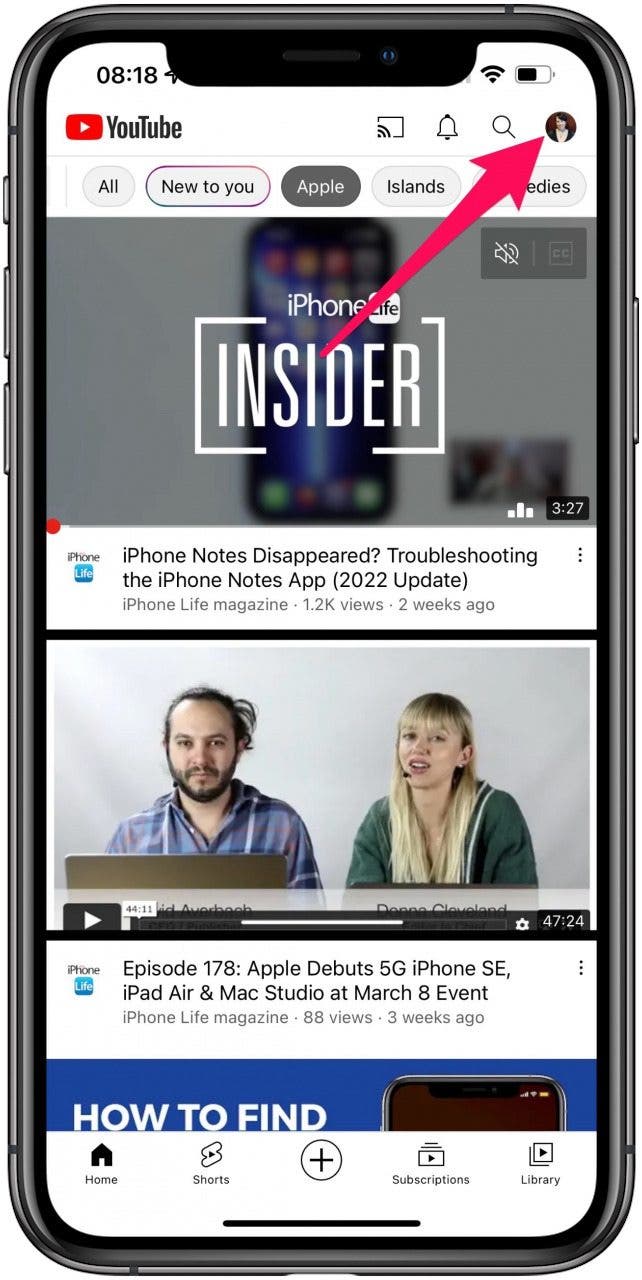
Both options for Premium plans currently offer a one month free trial, so if you're on the fence about whether the cost is worth it, you can try it out before you have to spend any money (just don't forget the date when you'll start being charged). If you need a free option for whatever reason, ad blockers are also an option.
Using ad blocking software on an iPhone is not always as easy as it is on other platforms, but it is still an option, and while the ability to block YouTube ads specifically is not always completely reliable (as YouTube is always working on new ways to stop blockers from working), they also offer the benefit of blocking annoying intrusions on other sites. Aside from the possibility that it will not always work as desired, the other downside is that this solution requires using third-party apps and does not allow viewing YouTube videos in the official YouTube app.
There are two different apps I have tested that seem work well for this. If you need some additional guidance for downloading, installing, and managing apps, we have a guide on this very topic that you may find useful, and be sure to sign up for our free Tip of the Day newsletter for other short, useful guides.
Watching YouTube with Firefox Focus
Firefox Focus is a privacy-focused web browser developed by Mozilla (developers of the original Firefox). Ad-blocking is always on with this browser app, so you can start browsing without ads right away.
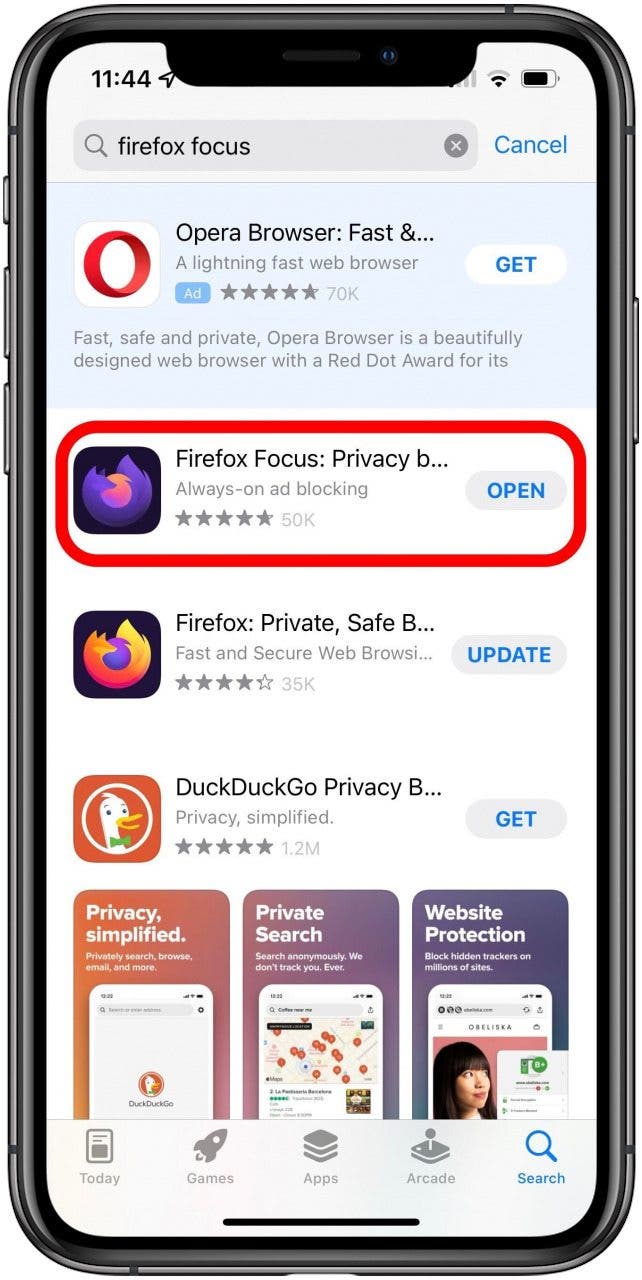
From here, you can use YouTube as you would from any mobile browser. I have tested used Firefox Focus to watch YouTube videos and initial testing was at least successful at blocking the ads that appear at the start of many videos.
Using 1Blocker to Block Ads in Safari
Unlike Firefox Focus, which is its own browser, 1Blocker is a browser extension for Safari. It can block ads, web trackers, social media widgets, and more, depending on how you configure it.
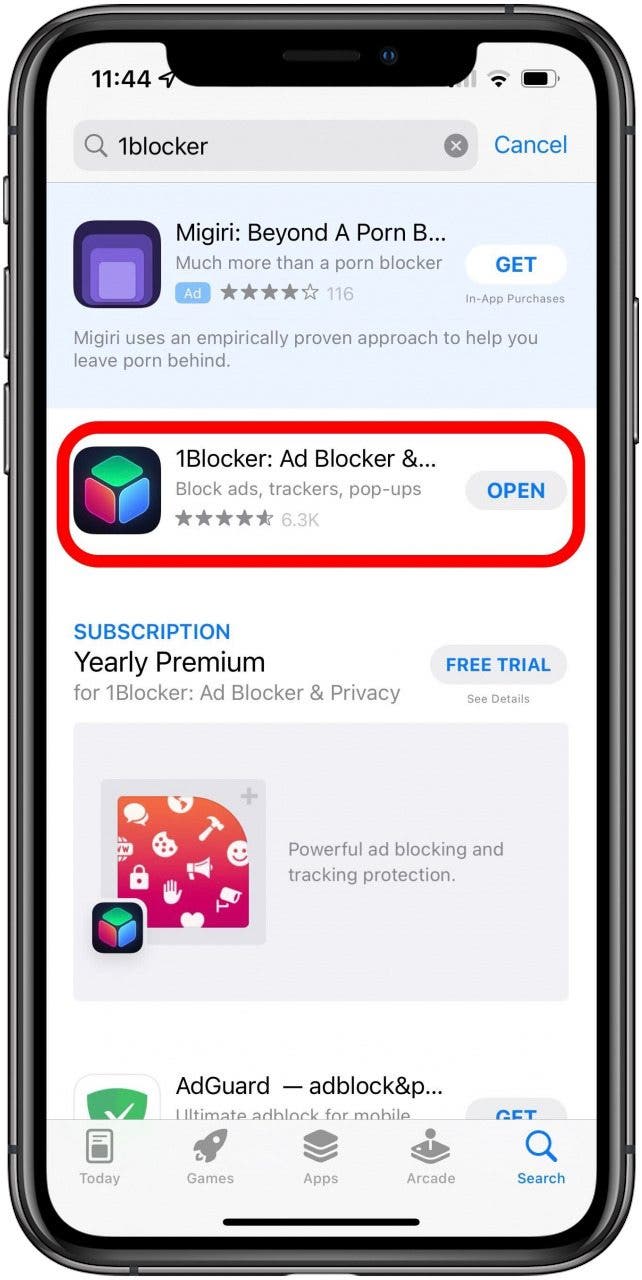
Remember that your luck may very with these third-party ad blockers, as YouTube and other sites are always trying to find ways to disable them. Some of our staff had luck with 1Blocker while others didn't. Hopefully, you have found this guide helpful and now have a way to watch YouTube in a way that will allow you avoid those annoying ads, whether that's by attempting to adblock YouTube, or by subscribing to YouTube Premium.
Author Details

Brian Peters

Article Spotlight
Matias is launching a brand new keyboard based on a classic design.

The Matias Sculpted Ergonomic Keyboard improves on the legacy of the beloved Microsoft Sculpt Keyboard with upgrades that make it more functional and comfortable than ever before! The Matias Sculpted Ergonomic Keyboard stays true to the spirit of the discontinued Microsoft original.
Featured Products

In episode 211, David and Donna cover Apple's "Let Loose" event that went live on May 7th, 2024. This event was all about the new supercharged iPads. From the AI-focused M4 chip to inky-black OLED, tune in to find out if it really is the biggest iPad update since its original release! Listen now and find out !
Most Popular

How to Tell If Someone Blocked Your Number on iPhone
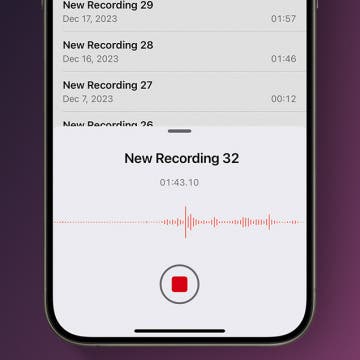
How to Record a Phone Call on an iPhone for Free

How to Tell If a Dead iPhone Is Charging

How to Schedule a Text Message on iPhone

10 Simple Tips To Fix iPhone Battery Drain

How To Put Two Pictures Together on iPhone

How To Find My iPhone From Another iPhone

Can iPhones Get Viruses? How to Detect & Remove Malware (iOS 17)
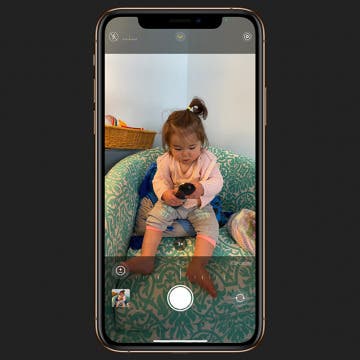
How to Adjust Exposure in the iPhone Camera App

iPhone Notes Disappeared? Recover the App & Lost Notes

How To Get an App Back on Your Home Screen
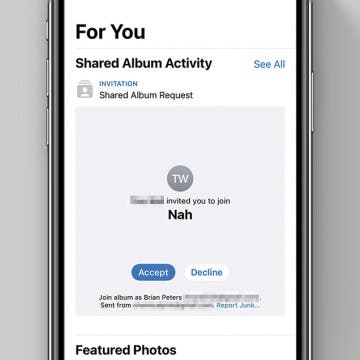
How to Accept a Shared Album Invite on Your iPhone
Featured articles, why is my iphone battery draining so fast 13 easy fixes.

Identify Mystery Numbers: How to Find No Caller ID on iPhone

Apple ID Not Active? Here’s the Fix!

How to Cast Apple TV to Chromecast for Easy Viewing

Fix Photos Not Uploading to iCloud Once & for All (iOS 17)

There Was an Error Connecting to the Apple ID Server: Fixed

CarPlay Not Working? 4 Ways to Fix Apple CarPlay Today
Check out our sponsors.

- Each email reveals new things you can do with your phone (and other devices) with easy-to-follow screenshots.
- Enter your email to get your first tip immediately!
How To Block YouTube Ads On Safari

- Software & Applications
- Browsers & Extensions

Introduction
Are you tired of being interrupted by pesky ads while trying to enjoy your favorite YouTube videos on Safari? You're not alone. The good news is that there are effective ways to block these ads and reclaim uninterrupted viewing pleasure. In this article, we'll explore three methods to block YouTube ads on Safari, allowing you to enjoy your content without the frustration of unwanted interruptions.
Whether you're a casual YouTube viewer or a dedicated content creator, dealing with ads can be a significant annoyance. These interruptions can disrupt the flow of your favorite videos, making it challenging to stay engaged. Fortunately, by implementing the right tools and techniques, you can regain control over your viewing experience and bid farewell to those intrusive ads.
Now, let's dive into the methods that will empower you to take charge of your YouTube viewing experience on Safari. Whether you prefer using browser extensions or exploring more advanced solutions, we've got you covered. Let's explore the options available to block YouTube ads and enhance your online video streaming experience.

Method 1: Using AdBlock Extension
One of the most popular and user-friendly methods to block YouTube ads on Safari is by utilizing the AdBlock extension. This powerful tool is designed to effectively filter out unwanted advertisements, providing a seamless and uninterrupted viewing experience.
To get started, simply navigate to the Safari Extensions Gallery and search for "AdBlock." Once located, click on "Install" to add the extension to your browser. After installation, AdBlock will automatically begin filtering out ads on YouTube, allowing you to enjoy your favorite content without interruptions.
AdBlock offers a range of customizable options, enabling you to tailor your ad-blocking preferences to suit your specific needs. You can easily whitelist certain channels or websites, ensuring that your support for content creators remains intact while still benefiting from an ad-free viewing experience.
Additionally, AdBlock provides real-time feedback, displaying the number of ads blocked on each webpage. This transparency allows you to see the impact of the extension in action, reinforcing the value it brings to your browsing experience.
Furthermore, AdBlock is continuously updated to stay ahead of new ad formats and techniques, ensuring that you remain protected from evolving advertising strategies. This commitment to ongoing development and improvement underscores the reliability and effectiveness of the AdBlock extension.
By leveraging the AdBlock extension, you can take control of your YouTube viewing experience on Safari, eliminating disruptive ads and enjoying uninterrupted content. With its user-friendly interface, customizable options, and proactive updates, AdBlock stands as a formidable solution for those seeking a seamless and ad-free browsing experience.
In summary, the AdBlock extension offers a straightforward and effective method to block YouTube ads on Safari, empowering you to reclaim control over your online video streaming experience. Whether you're a casual viewer or a dedicated content creator, AdBlock provides a valuable tool to enhance your browsing experience and ensure uninterrupted enjoyment of YouTube content.
Method 2: Using AdGuard Extension
When it comes to blocking YouTube ads on Safari, the AdGuard extension emerges as a robust and versatile solution. This powerful tool is designed to provide comprehensive ad-blocking capabilities, ensuring a seamless and uninterrupted browsing experience.
To begin, navigate to the Safari Extensions Gallery and search for "AdGuard." Once located, proceed to install the extension, seamlessly integrating it into your browser. Upon installation, AdGuard immediately begins filtering out unwanted ads on YouTube, allowing you to enjoy your favorite content without interruptions.
AdGuard offers a range of advanced features, setting it apart as a formidable ad-blocking solution. Its extensive filter list, regularly updated by a dedicated team, ensures that a wide variety of ads are effectively blocked, including those on YouTube. This comprehensive approach to ad blocking minimizes the likelihood of intrusive advertisements disrupting your viewing experience.
Furthermore, AdGuard's user-friendly interface empowers you to customize your ad-blocking preferences, providing granular control over the types of ads you wish to filter. This level of customization allows you to tailor your browsing experience to align with your specific preferences, ensuring that you can enjoy uninterrupted content while still supporting your favorite creators.
In addition to its ad-blocking capabilities, AdGuard offers enhanced privacy and security features, further enhancing your browsing experience. By blocking tracking and analytics scripts, AdGuard helps safeguard your online privacy, creating a more secure environment for your browsing activities.
Moreover, AdGuard's commitment to ongoing development and improvement ensures that the extension remains effective against evolving ad formats and techniques. This dedication to staying ahead of the curve underscores the reliability and effectiveness of AdGuard as a leading ad-blocking solution for Safari users.
In summary, the AdGuard extension stands as a powerful and versatile method to block YouTube ads on Safari. With its comprehensive ad-blocking capabilities, customizable features, and commitment to privacy and security, AdGuard empowers users to enjoy uninterrupted content while maintaining control over their browsing experience. Whether you're a casual viewer or a dedicated content creator, AdGuard offers a valuable tool to enhance your online video streaming experience on Safari.
Method 3: Using Pi-hole
For those seeking a more advanced and comprehensive approach to blocking YouTube ads on Safari, Pi-hole presents an innovative and powerful solution. Unlike browser extensions, Pi-hole operates at the network level, providing ad blocking for all devices connected to your network, including those accessing YouTube on Safari.
To implement Pi-hole, you'll need a Raspberry Pi or a similar device to serve as the host for the Pi-hole software. Once set up, Pi-hole acts as a DNS sinkhole, intercepting and filtering out ad-serving domain requests before they reach your devices. This network-level ad blocking ensures that ads are effectively blocked across all devices, including Safari browsers, without the need for individual browser extensions.
The installation and configuration of Pi-hole involve setting it up as your network's DNS server, allowing it to intercept DNS requests and filter out ad-serving domains. This process is well-documented and supported by a dedicated community, making it accessible to users with varying levels of technical expertise.
One of the key advantages of Pi-hole is its ability to block a wide range of ads, including those served on YouTube, without relying on specific browser-based solutions. This network-wide ad blocking ensures a consistent ad-free experience across all devices, providing a seamless and uninterrupted viewing experience for YouTube content on Safari.
Furthermore, Pi-hole offers extensive customization options, allowing users to fine-tune their ad-blocking preferences and whitelist specific domains as needed. This level of control empowers users to tailor their ad-blocking experience to align with their preferences while ensuring that legitimate content and services remain accessible.
In addition to ad blocking, Pi-hole provides valuable insights into network activity, allowing users to monitor and analyze DNS requests across their network. This transparency and visibility into network traffic contribute to a more informed and secure browsing experience, complementing the ad-blocking capabilities of Pi-hole.
By leveraging Pi-hole, users can enjoy a comprehensive and network-wide ad-blocking solution, ensuring uninterrupted YouTube viewing on Safari and other devices connected to the network. With its robust ad-blocking capabilities, extensive customization options, and network-level approach, Pi-hole stands as a formidable solution for those seeking a more advanced and comprehensive method to block YouTube ads on Safari.
In conclusion, the quest to block YouTube ads on Safari has led us through a diverse array of effective methods, each offering its unique advantages. Whether you opt for the user-friendly browser extensions like AdBlock and AdGuard or venture into the realm of network-level ad blocking with Pi-hole, the overarching goal remains the same: to reclaim uninterrupted enjoyment of YouTube content while maintaining control over your browsing experience.
The AdBlock extension, with its seamless integration and real-time feedback, provides a straightforward and accessible solution for Safari users seeking to eliminate disruptive ads. Its customizable options and proactive updates ensure that users can tailor their ad-blocking preferences while staying protected from evolving advertising strategies. AdBlock's commitment to enhancing the browsing experience makes it a valuable asset for those looking to streamline their YouTube viewing on Safari.
Similarly, the AdGuard extension offers a robust and versatile approach to ad blocking, combining comprehensive filter lists with advanced privacy and security features. Its user-friendly interface and customizable settings empower users to fine-tune their ad-blocking preferences, creating a tailored browsing experience that prioritizes uninterrupted content consumption while safeguarding privacy and security. AdGuard's commitment to ongoing development and improvement solidifies its position as a leading ad-blocking solution for Safari users.
For those seeking a more advanced and comprehensive ad-blocking solution, Pi-hole emerges as a game-changing option. Operating at the network level, Pi-hole provides ad blocking for all devices connected to the network, ensuring a consistent ad-free experience across Safari browsers and other devices. Its extensive customization options and network-wide approach make it a compelling choice for users looking to elevate their ad-blocking capabilities while gaining valuable insights into network activity.
In the ever-evolving landscape of online advertising, these methods stand as pillars of empowerment, offering users the means to take control of their browsing experience and enjoy uninterrupted YouTube content on Safari. Whether you're a casual viewer seeking seamless entertainment or a content creator striving to enhance your audience's experience, these ad-blocking methods provide valuable tools to achieve your browsing goals.
Ultimately, the journey to block YouTube ads on Safari is a testament to the ingenuity and adaptability of technology, empowering users to shape their online experiences according to their preferences. With these methods at your disposal, you can bid farewell to intrusive ads and embrace a browsing experience that revolves around uninterrupted enjoyment and control.
Leave a Reply Cancel reply
Your email address will not be published. Required fields are marked *
Save my name, email, and website in this browser for the next time I comment.
- Crowdfunding
- Cryptocurrency
- Digital Banking
- Digital Payments
- Investments
- Console Gaming
- Mobile Gaming
- VR/AR Gaming
- Gadget Usage
- Gaming Tips
- Online Safety
- Software Tutorials
- Tech Setup & Troubleshooting
- Buyer’s Guides
- Comparative Analysis
- Gadget Reviews
- Service Reviews
- Software Reviews
- Mobile Devices
- PCs & Laptops
- Smart Home Gadgets
- Content Creation Tools
- Digital Photography
- Video & Music Streaming
- Online Security
- Online Services
- Web Hosting
- WiFi & Ethernet
- Browsers & Extensions
- Communication Platforms
- Operating Systems
- Productivity Tools
- AI & Machine Learning
- Cybersecurity
- Emerging Tech
- IoT & Smart Devices
- Virtual & Augmented Reality
- Latest News
- AI Developments
- Fintech Updates
- Gaming News
- New Product Launches
How to Use Email Blasts Marketing To Take Control of Your Market
Learn to convert scanned documents into editable text with ocr, related post, how to make stairs planet coaster, how to rotate camera in planet coaster, how to make a good roller coaster in planet coaster, where is the minecraft folder, how to update minecraft windows, how to update minecraft education edition, related posts.
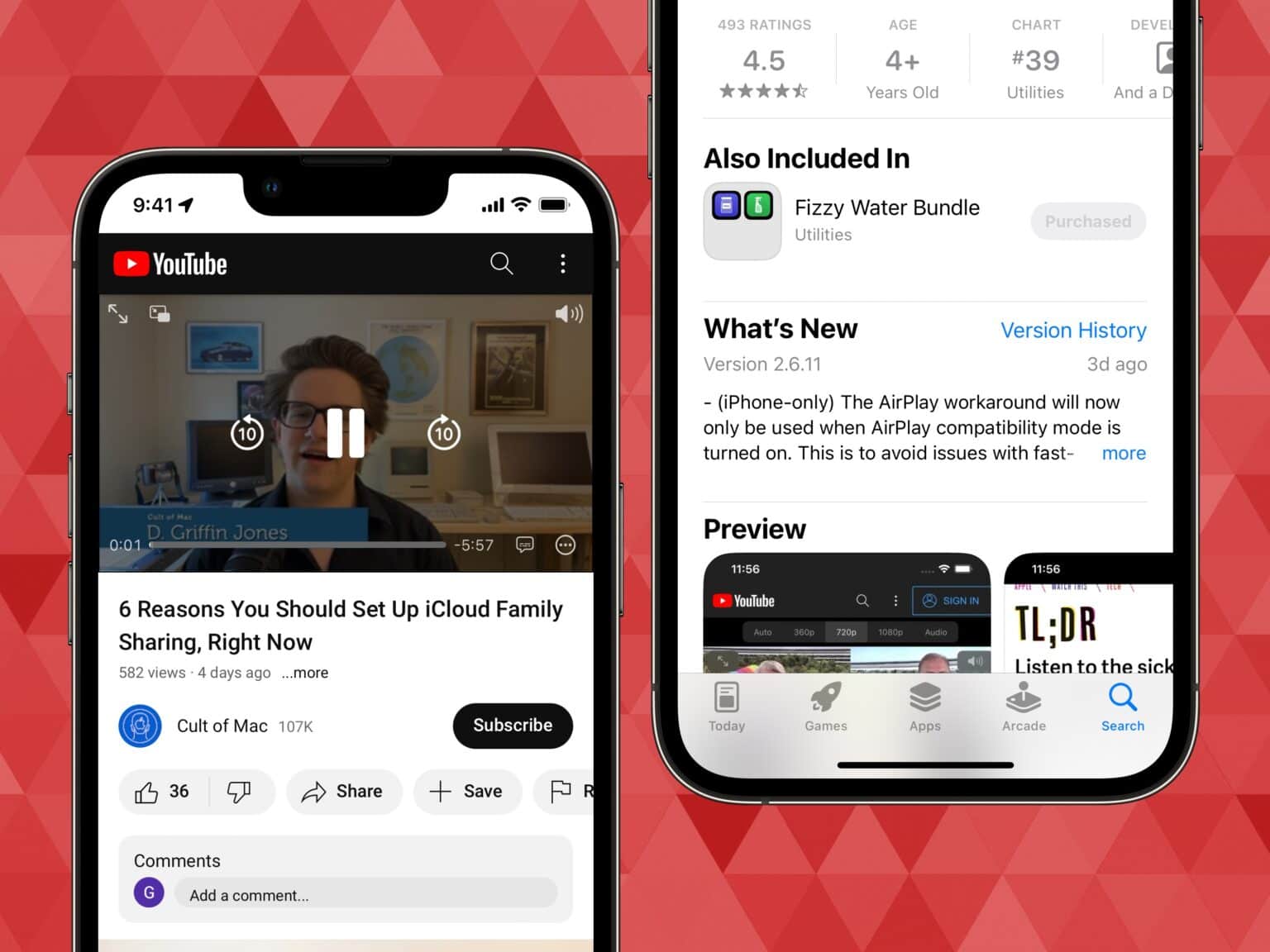
How To Block YouTube Ads On Safari Mac
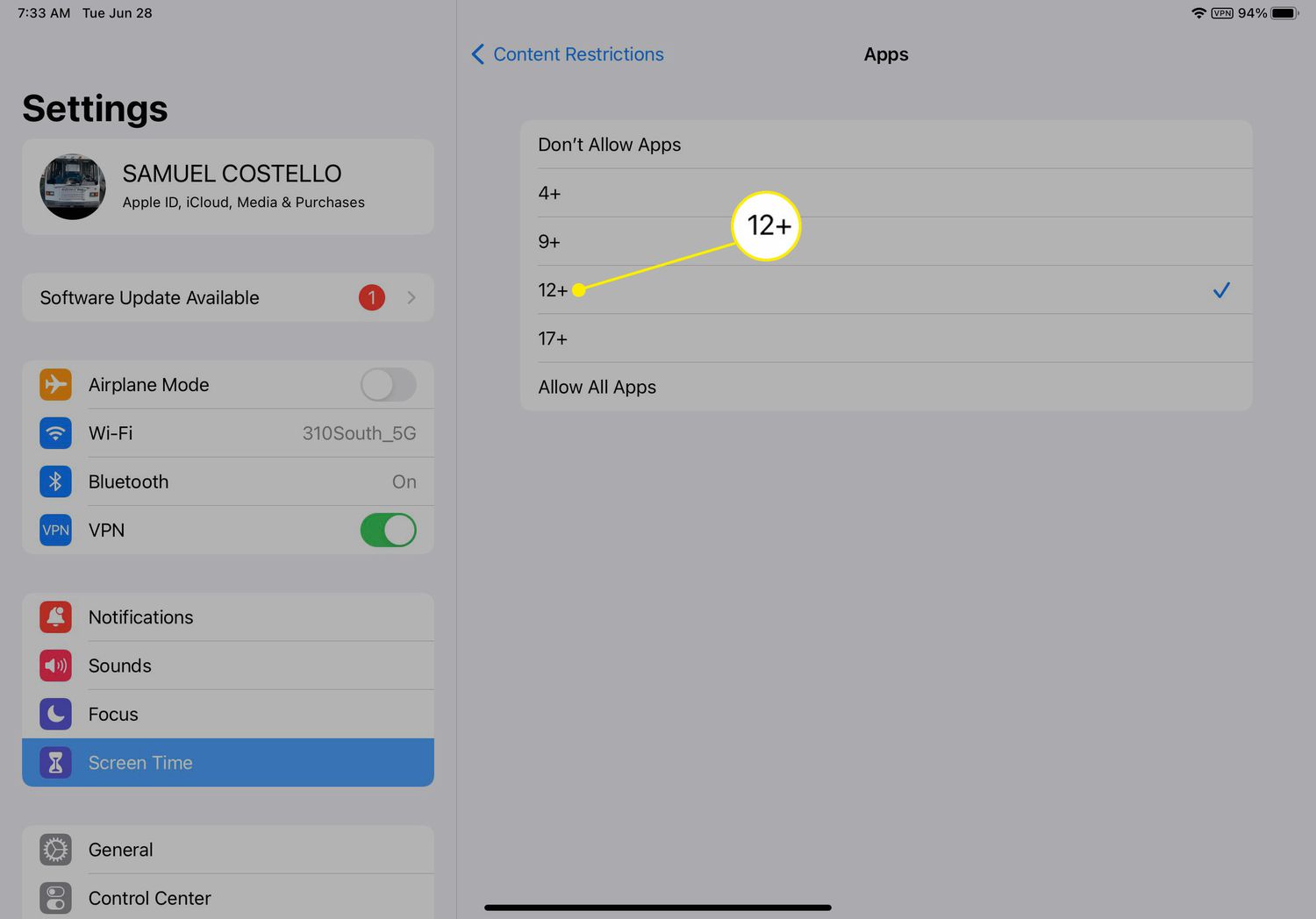
How To Restrict YouTube On Safari

How To Block YouTube From Safari

How To Download Blocked Youtube Videos

How Can I Get Youtube Premium For Free Forever

How To Download Videos To IPad

How To Download YouTube Music To Mac

How To Download Youtube Music Videos
Recent stories.

Top Mini Split Air Conditioner For Summer

Comfortable and Luxurious Family Life | Zero Gravity Massage Chair

Fintechs and Traditional Banks: Navigating the Future of Financial Services

AI Writing: How It’s Changing the Way We Create Content

How to Find the Best Midjourney Alternative in 2024: A Guide to AI Anime Generators

How to Know When it’s the Right Time to Buy Bitcoin

- Privacy Overview
- Strictly Necessary Cookies
This website uses cookies so that we can provide you with the best user experience possible. Cookie information is stored in your browser and performs functions such as recognising you when you return to our website and helping our team to understand which sections of the website you find most interesting and useful.
Strictly Necessary Cookie should be enabled at all times so that we can save your preferences for cookie settings.
If you disable this cookie, we will not be able to save your preferences. This means that every time you visit this website you will need to enable or disable cookies again.
Newsletters
- Our sponsors
- Watch Store
- Hot topics:
- Let Loose event
- Apple deals
- Apple rumors
- Editor’s picks
- Buying guides
Block all YouTube ads with the best Safari extension ever [Awesome Apps]
By D. Griffin Jones • 8:00 am, November 16, 2023
- Top stories
![Block all YouTube ads with the best Safari extension ever [Awesome Apps] Vinegar running on iOS](https://www.cultofmac.com/wp-content/uploads/2023/11/Vinegar-1536x1152.jpg)
If you love YouTube but hate YouTube ads, Vinegar is the best Safari extension you can download. It blocks all ads on YouTube and restores many iOS-native features like playing videos in the background, picture-in-picture, and more on iPhone, iPad and Mac alike.
YouTube ads are freaking insufferable. But if you don’t want to put down the dough for YouTube Premium (currently $13.99 per month), you can pay a one-time fee of just $1.99 to buy Vinegar for all your Apple devices.
If you ever watch YouTube, Vinegar is life-changing. Get it now on the App Store for iOS, iPadOS and macOS .
Vinegar: Block YouTube ads with native video playback on iPhone, iPad and Mac
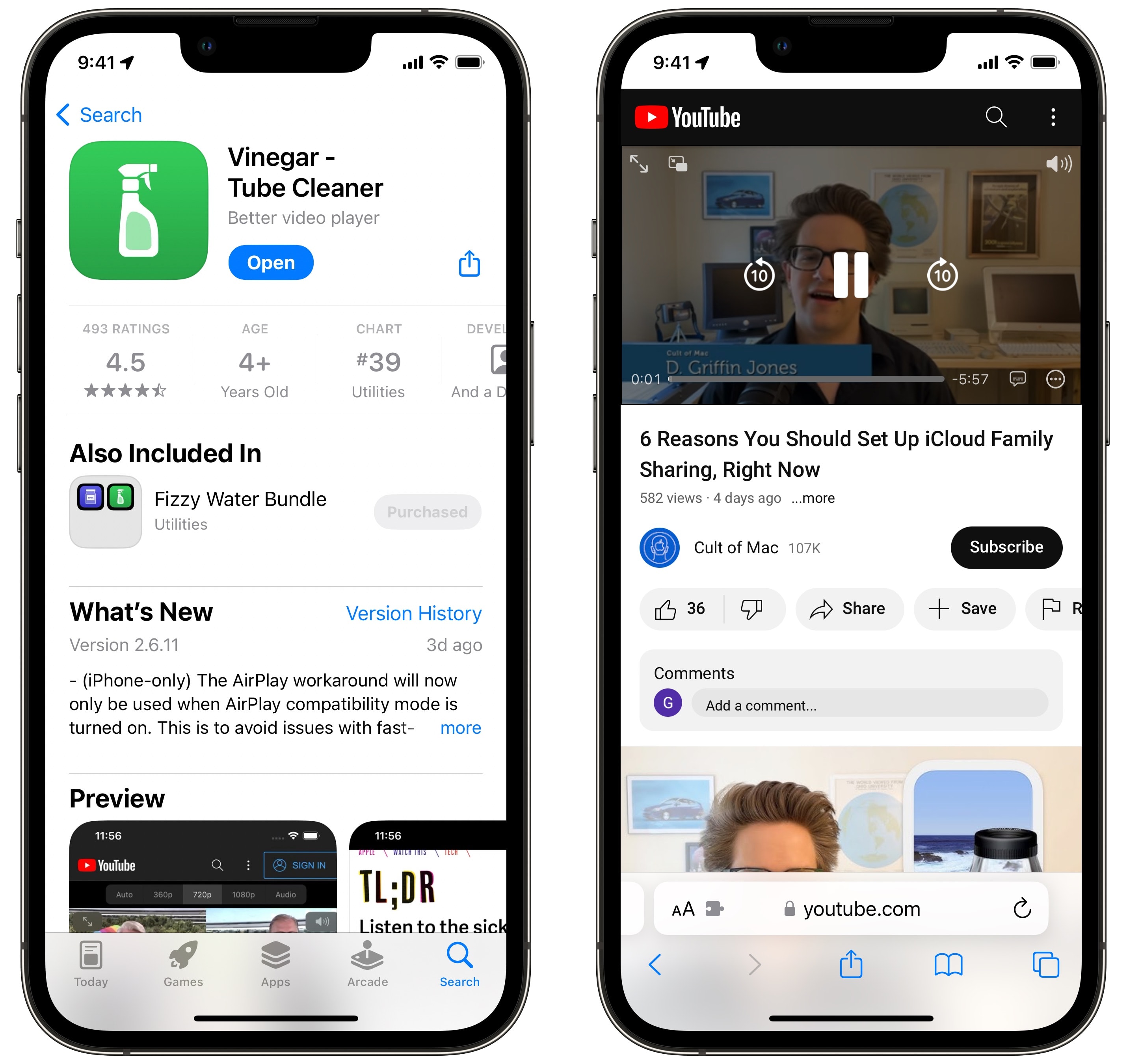
Effectively, what Vinegar does is really simple. It replaces the YouTube video player with the built-in iOS (or macOS) video player. That gives you all kinds of benefits.
First of all, you won’t see any ads. Nothing before the video, nothing interrupting the video, nothing in the sidebar. Need I say more? With Vinegar, you always jump straight into the YouTube content you want to watch.
Second, you get a bunch of features back that YouTube takes away from you. You can play a video picture-in-picture to keep watching while you send a text, scroll through social media or play a game. Or, you can play audio in the background without the video: Just start a video, go back to the Home Screen and hit the play button from Control Center.
Finally, if you care about such things, Vinegar uses Apple’s own video player instead of the YouTube interface. It’s a matter of personal preference, but I’m biased toward Apple’s design. I find the YouTube player cluttered and messy.
What’s the catch? Not much.
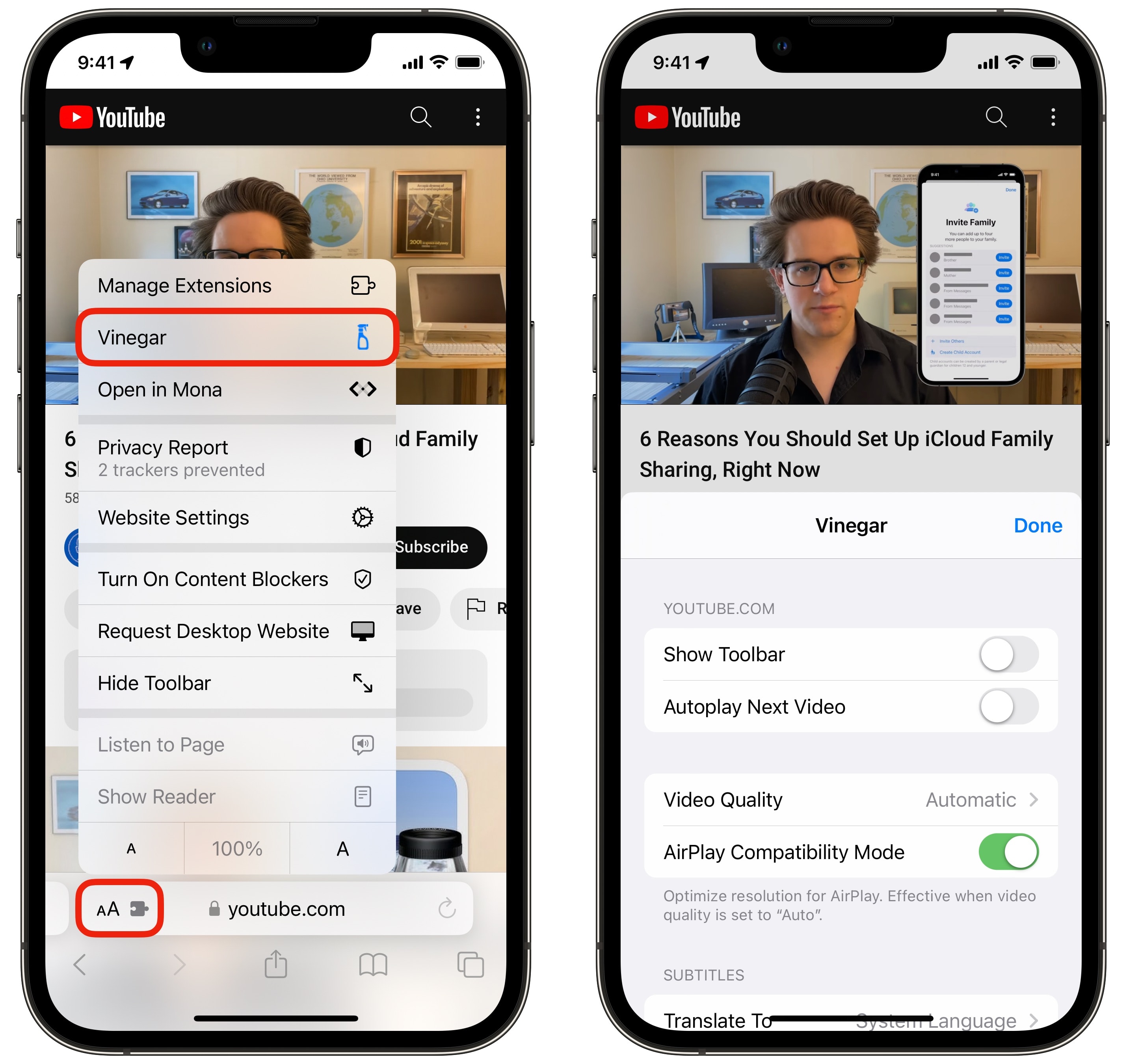
Keep in mind that, since Vinegar is a Safari extension, this only works on the youtube.com website, not the YouTube app. For best results, you should actually uninstall the YouTube app to prevent links from opening in it instead of Safari. That’s the only major downside to using Vinegar.
On a more minor note, some YouTube-specific features don’t work — information cards that show up in the middle of a video and endscreen buttons. But that’s a small price to pay in exchange for ad-free watching, in my opinion.
This YouTube ad blocker is astonishingly cheap
The literal price you must pay for Vinegar is $1.99, an absolute steal compared to the $13.99 monthly subscription fee for YouTube Premium. Vinegar has a totally clean App Privacy Report, with no data collected at all. And it’s a universal purchase that supports Family Sharing, so you only have to buy it once for your whole household to enjoy ad-free YouTube on all their devices.
Vinegar is a no-brainer to block YouTube ads on iPhone, iPad and Mac. I recommend it for everyone.
Download from: App Store
Daily round-ups or a weekly refresher, straight from Cult of Mac to your inbox.

Cult of Mac Today
Our daily roundup of Apple news, reviews and how-tos. Plus the best Apple tweets, fun polls and inspiring Steve Jobs bons mots. Our readers say: "Love what you do" -- Christi Cardenas. "Absolutely love the content!" -- Harshita Arora. "Genuinely one of the highlights of my inbox" -- Lee Barnett.

The Weekender
The week's best Apple news, reviews and how-tos from Cult of Mac, every Saturday morning. Our readers say: "Thank you guys for always posting cool stuff" -- Vaughn Nevins. "Very informative" -- Kenly Xavier.
Popular This Week
Whatsapp for iphone design refresh gives it a modern look, apple apologizes over reviled ‘crush’ ipad pro ad [updated again], m4 ipad pro vs. m2 ipad air comparison: do you really need the pro, cases, keyboards and screen protectors are ready for 2024 ipad pro and ipad air, could john ternus equal tim cook and steve jobs as apple ceo, should you upgrade to the 2024 ipad pro with m4 chip, features we expected but didn’t get in m4 ipad pro, ios 17.5 helps detect unwanted bluetooth tracking tags, first m4 ipad pro benchmarks show 21% performance increase over m3, today in apple history: bill gates predicts doom for apple’s biggest product.
NEW! Block annoying cookie banners
Tired of those frustrating pop-ups about cookies on every website? Start blocking them with Adblock Plus Premium and enjoy a better browsing experience today.
Surf the web with no annoying ads
- Experience a cleaner, faster web and block annoying ads
- Acceptable Ads are allowed by default to support websites ( learn more ) [ 1 ]
- Adblock Plus is free and open source ( GPLv3+ )
By clicking the button below, you agree to our Terms of Use .
Download Adblock Plus for another browser
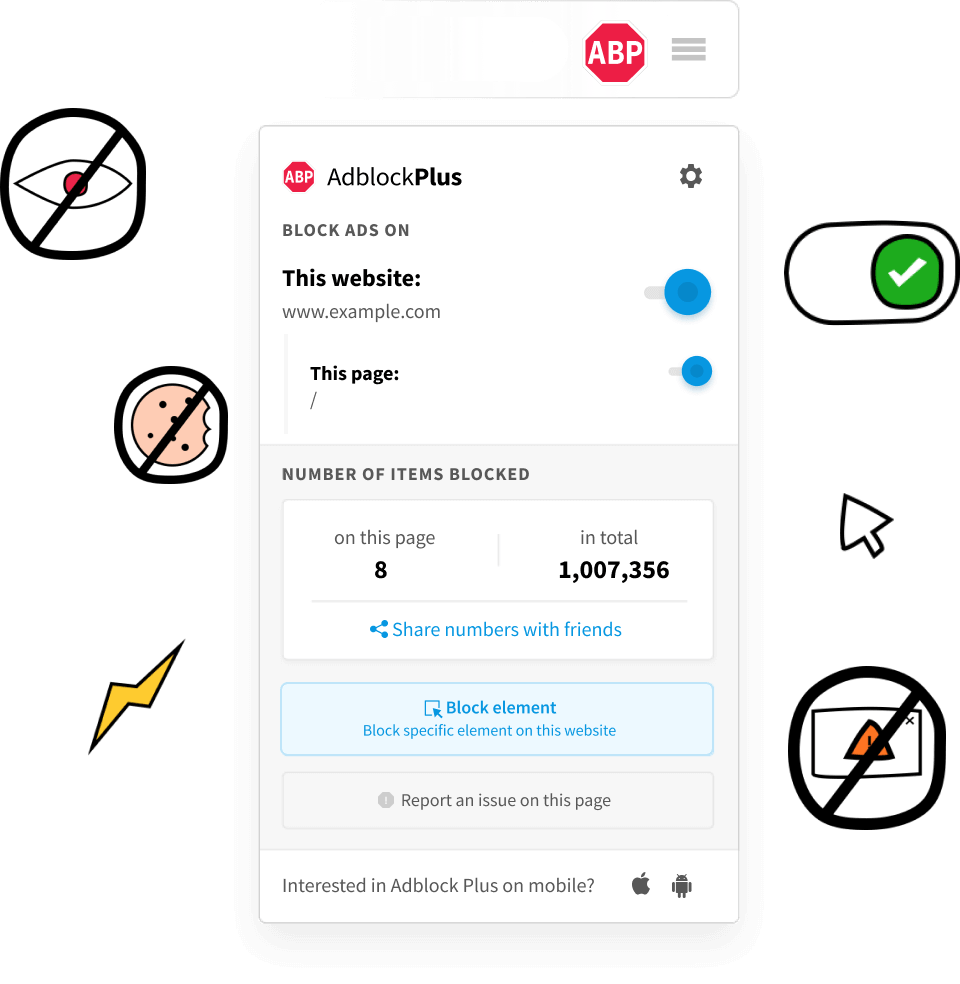
Block ads with Adblock Plus for Safari on iOS
- Block annoying ads
- Save data and battery life
- Block malware, tracking and more
- Works exclusively for Safari
Get Adblock Browser
The best ad-blocking browser for Android
- Block tracking
- Avoid malware
Block ads with Adblock Plus for Samsung Internet
Designed specifically for Samsung Internet
As Mentioned On:
Faster, more enjoyable browsing.
Block ads that interrupt your browsing experience. Say goodbye to video ads, pop-ups, flashing banners and more. Blocking these annoyances means pages load faster.
Keep Your Data And Devices Safe
With Adblock Plus avoiding tracking and malware is easy. Blocking intrusive ads reduces the risk of "malvertising" infections. Blocking tracking stops companies following your online activity.
Not All Ads Are Bad
Websites need money to stay free. Support them by allowing Acceptable Ads (enabled by default). Want to hide all ads? No problem. Learn how
Want to block ads and disable tracking on mobile devices?
Adblock browser app.
From the team behind Adblock Plus, the most popular ad blocker for desktop browsers, Adblock Browser is now available for your Android devices.
What is Adblock Plus?
Adblock Plus is a free extension that allows you to customize and control your web experience. Block annoying ads, disable tracking, block sites known to spread malware and lots more. Available for all major desktop browsers and mobile devices.
Adblock Plus is an open source project licensed under GPLv3 and subject to its Terms of Use .
- Participants cannot pay to avoid the criteria . Every ad must comply.
- For transparency, we add all Acceptable Ads to our forum so that our community of users can provide feedback.
- We listen to our users. If an Acceptable Ads proposal is flagged by our community for a legitimate reason, we will remove it from the whitelist.
- We are able to keep our open source product free by charging large entities a fee for whitelisting services. For the other roughly 90 percent of our partners, these services are offered free of charge.
Cookie notice We use some cookies to give you the best experience on our website. By using our site you are aware that we are using cookies and you can change this any time. Learn more
Necessary cookies
Used to remember your privacy preferences. They cannot be switched off.
Tracking cookies
We use these to analyze website traffic.
We use some cookies to give you the best experience on our website. Read more
Change settings
Cookie preferences
Adblock Plus for Safari (ABP) 4+
Block bad, disruptive ads.
- 4.4 • 7.8K Ratings
Screenshots
Description.
The easy way to block ads on your iPhone and iPad. Annoying ads like pop-ups, video ads, banners and ads disguised as content are things of the past thanks to Adblock Plus (ABP)! Safari users enjoy a peaceful and delightful web experience when using Adblock Plus, the world’s number 1 ad blocker. No disruptive ads. No tracking. No nasty viruses. REPUTABLE Adblock Plus has been the most downloaded, free ad blocker on the market since 2006. Its unique Acceptable Ads feature, turned on by default, shows occasional ads that aren’t disruptive in order to help support great content creators. You can choose to block these ads by simply turning off the Acceptable Ads feature in the ABP settings. SAFE AND PRIVATE Browse more safely and securely. Adblock Plus for Safari: - Prevents nasty stuff like malware and tracking that can hide behind ads - Reduces the risk of malware infection - Enhances your privacy CONSCIOUS BROWSING Ads can cause pages to load slower, thus eating up your data plan and consuming your battery. By using Adblock Plus for Safari you: - Save data - Save battery life Download Adblock Plus for Safari on iOS - it’s FREE! By downloading and installing the application, you agree to our Terms of Use. https://adblockplus.org/terms ------ About the people behind Adblock Plus for Safari on iOS We are a globally distributed, yet tight-knit group of developers, designers, writers, researchers, and testers. By supporting a fair and profitable Internet, we remain optimistic about the future of the web. Our mission is to create a sustainable product that makes your everyday life a little easier. ------ Enjoying the app? Please leave us a 5-star review! Facebook: https://www.facebook.com/adblockplus Twitter: https://twitter.com/adblockplus YouTube: https://www.youtube.com/user/AdblockPlusOfficial Instagram: https://www.instagram.com/adblockplus
Version 2.2.14
**Please open ABP after updating so that the new filter lists are immediately synced!** What's New? - Improved ad blocking quality Questions or feedback? Send us a message at [email protected]. Like the app? Write a review :)
Ratings and Reviews
7.8K Ratings
Failed on first two websites
I turned this on in Safari Private Mode and see ads all over CNN and FOX8. Three or more per page. Then I turned off acceptable ads. All but the most annoying ad disappeared. Does not block NPR Paywall overlay.
The Best Ad Blocking Tool
I’ve used Adblock Plus for Safari for about two years, along with two other ad blockers. Recently I upgraded my iPad to iOS17. Suddenly got ads all over the place! I checked the Adblock Plus and readjusted my enabled websites list, and closed the iPad, then re-opened it after a few minutes. Voilá— no more ads! This app is much more efficient than the other two ad blockers I used before. My suggestion to anyone having ad problems after installing an iOS update is just to check and recalibrate your Adblock Plus, and close your device, then re-open it. I really hate ads, so I love this app.
Stopped Working
After updating to iOS 17, this app has become completely useless. The thing I loved most about this app is that it would stop ads from opening their own tab in safari but it no longer prevents that from happening & just all around stopped blocking ads for me. Hoping it gets fixed cause this is the only adblocker I’ve ever liked. Other apps block pop up windows but they still open & say “this content is blocked” which you then have to close the tab. That never happened with Adblock Plus, it would literally prevent an advertiser from opening a window PERIOD. Hence why it’s my fav 🙁
App Privacy
The developer, Eyeo GmbH , indicated that the app’s privacy practices may include handling of data as described below. For more information, see the developer’s privacy policy .
Data Not Linked to You
The following data may be collected but it is not linked to your identity:
- Diagnostics
Privacy practices may vary, for example, based on the features you use or your age. Learn More
Information
English, Arabic, Dutch, French, German, Greek, Hungarian, Italian, Japanese, Korean, Polish, Portuguese, Russian, Simplified Chinese, Spanish, Turkish
- App Support
- Privacy Policy
More By This Developer
Crystal Adblock – Block unwanted ads!
You Might Also Like
AdLock: Ads Blocker & Privacy
Ad Remover - Ad Blocker
Lockdown Privacy: AdBlock VPN
Turn Off the Lights for Safari
BlockSite: Block Apps & Focus
SkyBlue Ad Blocker for Safari
Apple’s Upcoming Native Ad-Blocker in Safari Worries UK Media Group
Apple’s upcoming iOS 18 update is anticipated to be one of the biggest updates, slated to debut during WWDC . One of the features that the next iOS will pack could be an AI-powered privacy feature, dubbed “Web Eraser” in Safari, to remove ads or other unwanted content on the website. For better understanding, let’s just assume that it will be a native ad blocker for Safari.
As beneficial as it may sound on the consumer side, the publishers don’t seem very happy with this upcoming move. UK’s Media group has warned Apple that any such move—to browse the web while removing certain portions of the website, including ads—would put their businesses (or journalism) at risk, reports the Financial Times . Given that publishers heavily depend on advertisements to cover operational expenses, their concern is understandable.
News Media Association, comprising 900 titles at all levels—national, regional, and local, sent a letter to Apple’s government affairs chief in the UK raising concerns about how this would affect “digital revenues in the industry.” For reference, popular and reputable titles such as The Times , The Guardian , the Daily Mail , and the Daily Mirror are a part of the News Media Association (NMA).
The letter sent by NMA noted, “ad-blocking is a blunt instrument, which frustrates the ability of content creators to sustainably fund their work and could lead to consumers missing important information which would otherwise have been very useful to them.”
The report further mentions how Apple’s App Tracking Transparency banned apps and advertisers from “collecting data about iPhone users without their explicit consent.” Most people said no to giving permission, so Apple made their privacy rules even stricter in later iPhone updates. Notably, big techs including Google and Meta have threatened publishers, which has “led to a drop in digital revenue for many newspaper groups.”
Leave a Reply Cancel reply
You must be logged in to post a comment.
This site uses Akismet to reduce spam. Learn how your comment data is processed .
- Abhinav Anand

IMAGES
VIDEO
COMMENTS
An ad blocker extension is a software that blocks or filters out unwanted ads from websites. There are many ad blocker extensions available for Safari, and one of the best ones is Ghostery Ad Blocker. Ghostery's Safari YouTube ad blocker is a powerful tool that blocks ads on YouTube and other websites. With Ghostery's ad blocker extension ...
🌐Diferent links to Block YouTube Ads on Safari:1️⃣ AdGuard Ad Blocker: https://geni.us/adguard2️⃣ Extension "Adblock for Youtube": https://apps.apple.com/us...
Now proceed at this link, tap "Get Shortcut", and you'll see the contents of the AdGuard shortcut. To install it, scroll a bit down and tap "Allow Untrusted shortcut" (yeah, we know, it doesn't sound too good). Now open YouTube in Safari. Click on the bottom icon in the middle, scroll to the end and select Block YouTube Ads (by AdGuard).
AdBlock is the only YouTube ad blocker with an easy-to-use option for allowing ads on your favorite channels, making it simple to support content creators. ... Block YouTube ads in Chrome, Firefox, Edge, Safari, Android or iPhone. More Than a YouTube Ad Blocker. AdBlock does more than block YouTube ads, it actually makes YouTube better! ...
Tap the Extensions option. Ensure that the 1Blocker - Block Ads toggle is on (green) though I prefer to turn all blockers on and only unblock things if they cause issues. Tap the Safari tab at the bottom of the screen. On the Safari filters screen, make sure the Block Ads toggle is turned on (green).
By understanding the nature of YouTube ads on Safari Mac, users can make informed decisions about the most suitable ad-blocking solutions to implement, ensuring a more seamless and enjoyable viewing experience. Methods to Block YouTube Ads on Safari Mac 1. Use Ad-Blocking Extensions
Video tutorial on how to install an ad-blocker on Safari on Mac, macOS and M1 Mac.AdGuard App Store link: https://apps.apple.com/us/app/adguard-for-safari/id...
Adguard, Wipr, and 1Blocker are among the best ad blockers for Safari. Pranay Parab. December 16, 2022. Credit: tinhkhuong - Shutterstock. Unlike Firefox and Chrome, it's not easy for Mac users ...
Method 1: Using AdBlock Extension. One of the most popular and user-friendly methods to block YouTube ads on Safari is by utilizing the AdBlock extension. This powerful tool is designed to effectively filter out unwanted advertisements, providing a seamless and uninterrupted viewing experience. To get started, simply navigate to the Safari ...
Vinegar: Block YouTube ads with native video playback on iPhone, iPad and Mac. It works on every YouTube video, like this one. Screenshot: D. Griffin Jones/Cult of Mac. Effectively, what Vinegar ...
AdGuard extension is supposed to bring back the high quality ad blocking back to Safari. AdGuard app has filters optimized specifically for Safari, which ensures the best filtering quality. Between AdGuard's own filters and other popular lists, you have more than 50 filters to choose from. More ads blocked means fewer ads loaded.
These rules are then used by Safari to actually do the 'blocking' part of the job. This diagram illustrates how content blockers work in Safari. Each content blocking rule is a JSON object that consists of 2 parts: "trigger" and "action". The "trigger" part defines what requests the rule should be applied to. And the "action" part, as the name ...
Learn how to block ads on YouTube and other websites in Safari for free using AdGuard. This will also block other things relating to privacy, security, and s...
We've designed the Safari ad blocker to be fast and ultra-light on your Mac's resources. The app blocks annoying ads such as pop-ups, video ads and banners, enabling pages to load faster. Support fair publishers Websites need money to stay free. Support them by allowing Acceptable Ads (on by default).
AdBlock for Safari is a powerful and simple-to-use ad blocker. It stops annoying pop-ups, removes autoplay video ads, and blocks obnoxious audio ads. It also gives you control over which ads you see and what websites you support. You can tell AdBlock to stop working on certain websites, allow ads on sites you want to support, and get easy ...
Total Adblock - Best adblocker for Safari. A secure ad-blocker Safari extension for iOS devices. Premium plan includes anti-virus protection and an exclusive YouTube ad-blocker. CleanWeb - Surfshark's multi-purpose ad-blocker removes all ads from Safari before the page displays - including video ads. The blocker forms part of the Surfshark ...
I still use Safari, but my main browser is FF. I use vinegar extension to skip ads that's not a abblocker but you won't even notice the difference. I use adguard but I also have youtube premium (got it for cheap via vpn). Vinegar has worked great for me for years. See this post talking about Anti-Adblock Killer (List).
Adblock Plus, the most popular ad blocker on Firefox, Chrome, Safari, Android and iOS. Block pop-ups and annoying ads on websites like Facebook and YouTube.
This article covers AdGuard for iOS, a multifunctional ad blocker that protects your device at the system level. To see how it works, download the AdGuard app. ... Open youtube.com in Safari. Choose a video and tap Share. Tap Block YouTube Ads (by AdGuard). AdGuard will open its ad-free video player. Edit this page.
The easy way to block ads on your iPhone and iPad. Annoying ads like pop-ups, video ads, banners and ads disguised as content are things of the past thanks to Adblock Plus (ABP)! Safari users enjoy a peaceful and delightful web experience when using Adblock Plus, the world's number 1 ad blocker.…
Total Adblock - best ad blocker for YouTube in 2024. NordVPN Threat Protection - trustworthy YouTube ad blocker with a money-back guarantee. Surfshark CleanWeb - YouTube ad blocker for multiple devices. Atlas VPN Shield - inexpensive ad blocker. Proton VPN NetShield - customizable ad blocker for ads and malware.
This is the easiest way to block all ads on Safari. Block all annoying ads from any websites using Adblock Plus. Even the ads before youtube videos! Get Ad...
Over time, the Safari ad blockers have got a lot better and can now block all ads (including YouTube ads), trackers and other web page annoyances. I develop a free ad blocker called Magic Lasso Adblock that works on iPhone, iPad and Mac but there are a few other options and alternatives as well.
Apple's Upcoming Native Ad-Blocker in Safari Worries UK Media Group. Apple's upcoming iOS 18 update is anticipated to be one of the biggest updates, slated to debut during WWDC. One of the ...
Now you can watch videos without annoying drop-in commercials at a price of only a couple extra taps. Follow these steps to watch YouTube without ads. A two-step guide on how to do this: Open YouTube app and start the video you want to watch. Tap on the Share button and select AdGuard for Android from the list of apps.